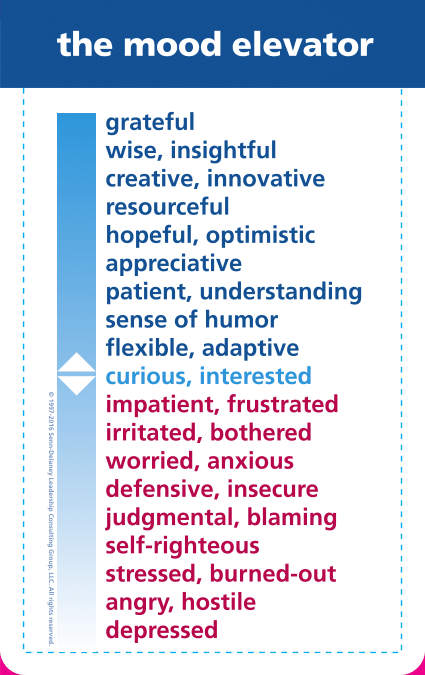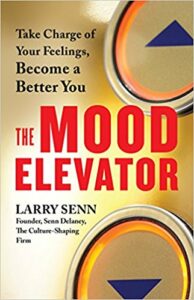Master Your Moods
I’m sure you’ve had this day:
You wake up and you’re feeling amazing. Then you spill something on your clothes at breakfast and get stuck in a traffic jam on the way to work. You realize you will be late for your first appointment, and your frustration grows by the minute.
Fast forward hours later, and you’re feeling great again.
Up and down. Down and Up.
How do you stop the wild mood swings?
CEO Forum Magazine dubbed him the “father of organizational culture” and thousands have attended his company’s training programs. Larry Senn is chairman and founder of Senn Delaney, a firm dedicated to helping organizations shape their culture. I recently spoke to him about his new book, The Mood Elevator: Take Charge of Your Feelings, Become a Better You.
He helps you understand your moods and gain control, limiting the time in the basement and helping you stay in the upper floors.
Develop a Healthy Response
The Mood Elevator. Unfortunately, all of us are experienced with the dramatic ride. What are some of the triggers that cause a sudden shift in floors?
Yes, to be human means we all ride the Mood Elevator. Since our thoughts create our moods, dramatic drops in mood come from big shifts in our thinking. We start our day in a great place and high mood after a morning run and a good breakfast. Then we open an email, and a colleague says he heard we may not be closing the deal we were counting on. Our mind starts to spin as we run through all the possible negative consequences of that happening. That creates feelings down the Mood Elevator like insecurity, worry, self-judgement and mild depression.
Things like that happen in major and minor ways as life comes at us. What’s interesting is how we each deal with circumstances can be very different. Another person might get the same email and go to curiosity, a much healthier level, first. “I wonder what that might be about or if it is even true – I’ll check it out.” They might also go to creative and resourceful and start to think about all the ways they can best secure the deal.
As Shakespeare said, “There is nothing either good or bad, but thinking makes it so.”
Would you comment on any career limitations and/or leadership problems you’ve seen due to leaders not having conscious control of their floor?
I have observed CEOs self-destruct as well as very smart and capable leaders ruin their careers and their marriages because they lacked emotional control and led from the lower floors of the Mood Elevator. I’ve also seen leaders become world class CEOs by learning how to better ride the Mood Elevator.
The reason is simple − our thinking is reliable and wise when in the higher mood states, while it is very unreliable in the lower floors. Anyone who has ever said something to a loved one they wished they could take back has experienced the phenomenon. We have very low emotional intelligence (EQ) when down the elevator. That means leaders can’t build great teams, create great cultures, be as creative or make good decisions from the lower floors of the elevator.
Use Your Feelings as a Guide
You talk about the power to brake. What are a few ways we can slow, stop or resist our emotional impulses?
It all starts with learning to use your feelings as your guide. When we are self-aware, we can tell when we are worrying, angry, judgmental, self-righteous or depressed. We will all experience those feelings at times. Think about it like having to drive on an icy road at night. You may have to do it, but you proceed with caution. Delay big decisions, pause before putting your foot in your mouth, and tell yourself your thinking is likely to be flawed.

When unwanted things happen or people do things that don’t make sense to me, I have feelings of intensity. That’s my clue. What I find most helpful is to first pause, take a deep breath and center myself. Then I try to use what I call in the book the “brake” on the Mood Elevator. That break is shifting my thinking from judgement to curiosity. What am I missing here? Why might that have made sense to them in their thinking? What lesson can I learn from that? As I tell leaders in our off-sites, if they just lived more of their life in curiosity instead of judgment they would have a different experience of life and different results.
Would you talk about “living in mild preference?”
 The more we insist that people and life circumstances have to be exactly the way we think they should be, the harder life will be. That’s because we will live on the bottom floors of the elevator in irritation, bother, impatience, judgment, anger and self-righteousness.
The more we insist that people and life circumstances have to be exactly the way we think they should be, the harder life will be. That’s because we will live on the bottom floors of the elevator in irritation, bother, impatience, judgment, anger and self-righteousness.
My metaphor is getting my roller bag down the aisle in an airplane. As I pass through first class, my bag glides effortlessly. Then I reach economy, the aisle narrows and my bag bounces off both sides, flips over and I have to drag it with me. Just a few inches can make a huge difference. People who understand mild preference have wider aisles.
Most of what couples fight about is small stuff. Should we have Italian or Sushi doesn’t need to be World War 3. If we can just learn to not sweat the small stuff and be wiser about when we really should take a stand, life would be a lot easier. The paradox is that when we don’t ramp up, we are wiser, more articulate and persuasive, and get more of what we want.
Shift Your Set Point
Shifting your set point is a concept I associate with weight. You talk about ways to shift your set point higher up the Mood Elevator. Would you share a few of these strategies?
Just like we can get stuck at a weight or a weight range in life, we can get stuck in moods. Have you ever known someone who got off the elevator, moved in, and furnished the floors of impatient, irritated, judgmental or worried? They can get stuck there by a phenomenon we call “unhealthy normal.” It’s like living next to a freeway and no longer hearing the noise. They stop noticing they are that way. The first step in shifting the “set point” is to develop self-awareness so those feelings become a loud bell.
In addition, there are two practices which can shift the whole range of your moods up. You will still visit most floors, including lower ones, but the duration and frequency of visits will be shorter. The first is simply to take better care of yourself. There is a direct correlation between physical and mental well-being. Sleep is restorative, and we all could use more. Exercise clears the mind and creates free Mood Elevators called endorphins, and diet impacts our mind and body. The second and even more powerful way to shift your set point is by maintaining a special form of perspective – a gratitude perspective.
Cultivate Gratitude
What are a few ways to cultivate an attitude of gratitude?
Cultivating an attitude of gratitude is powerful and yet not easy. We all have so much to be grateful for, but few of us maintain enough of a gratitude perspective. Perhaps it’s because, as Eckhart Tolle has said, “Humans tend to think more about what is not working than what is, and what they don’t like more than what they do like.” Gratitude so powerfully impacts our moods and experience of life that it is a valuable practice to have.
If you look at The Mood Elevator, the nature of thought is much quieter toward the top. When we are grateful for a sunset or the smile of a child, there is no obvious thought – just a feeling. Our thinking at lower levels, like worry or anger, is very intense and busy. This means that one path to feeling more grateful is any practice that quiets the mind. I find taking deep breaths throughout the day, prayer, or even brief mediation very helpful.
Combining quiet times with even a few minutes of thought about what you are grateful for has been shown to make a difference in all aspects of life. I think about my wife and kids, a job with purpose, and the health to run triathlons at 80. A hint: you will run out of big things like family and health pretty quickly, but there is an inexhaustible list of little things each day like the sun being out, a good cup of tea or coffee, a smile from a loved one, or for me a great pillow at the hotel I stayed in that night.
Most of this book is focused on staying on the higher levels, which is vitally important for leaders. But you acknowledge we all have down days. What if you find yourself on the bottom and you feel trapped?
Learning to ride the Mood Elevator is a bit like learning to ride a bike − you need to find what works for you. Sometimes it is best to just momentarily surrender to a down mood. My wife, Bernadette, is an up person, but she does well when down the Mood Elevator, too. She has a deep faith that the mood will pass like a rain storm and then the sun will be out again soon. She also does something a CEO once wisely said to me, “Larry, I can’t always be up, but I can learn to do no harm when down.”
I’m more of doer and a fighter, so I try several things when I find myself way down. The underlying principle is that thoughts create moods, so if I can quiet my mind or shift my thinking, I will shift the mood. The first rule is to get plenty of sleep and exercise. A good night’s sleep and a good run or walk often clears my head and my mood shifts. I also try what I call Pattern Interrupts, based on the concept of shift your thinking, shift your mood. We each have our own ways − some examples include: hobbies, great people to be around, getting lost in a book, or calling a loved one.
Once again, it is all about regaining perspective − especially a gratitude perspective. We are all so blessed but forget. It’s hard to stay down when you really count your blessings.
For more information, The Mood Elevator: Take Charge of Your Feelings, Become a Better You.

